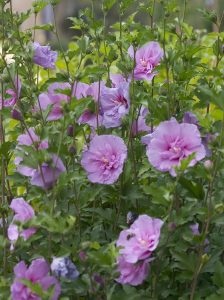by Ken Lain, the mountain gardener

Breathtaking large blue flowers are adorned with lacy centers to create anemone-like blooms. Each stem of this hardy Hibiscus is packed with numerous buds. This vigorous head high shrub offers late-season color for hedges and perennial or shrub borders. Blooms continuously over a long season, and rarely sets seeds. Makes a beautiful informal hedge or screen, and is easily trained into a small tree. Available Prescott colors show in blue, purple, white, red, and pink for years of enjoyment.
7 Helpful Tips on Growing the Rose of Sharon
Contrary to its name, the plant is not really a rose at all; instead, it is a member of the Malvaceae or mallow family, with origins hailing from India and China.
Botanical Name – Hibiscus syriacus
Common Name – Rose of Sharon, Althea, Korean rose, rose mallow, Chinese Hibiscus
Plant Type – Deciduous shrub
Mature Size – 8′ feet tall with widths half that
Sun Exposure – Full sun to partial shade
Soil Type – Rich and moist
Soil pH – Acidic to slightly alkaline
Bloom Time – summer, early fall
Flower Color – White, red, lavender, or light blue
Hardiness Zones – 5 to 9
Native Area – China, India
How to Grow Rose of Sharon Plants
This high head shrub thrives in moist, well-drained soil. Rose of Sharon is tolerant of air pollution, heat, humidity, poor soil, and drought.
Light
Rose of Sharon prefers full sun and may fall prey to fungal damage if grown in shaded. That is because excess moisture is retained in shaded areas, and it is precisely in moist conditions that fungus thrives.
Soil
This plant thrives in rich soil. It can tolerate many soil types from sand, clay, chalk, and loam, but is a survivor.
Water
The plant is reasonably drought-tolerant. In fact, if your rose of Sharon has yellow leaves, it is more likely due to overwatering than to a lack of water.
Temperature and Humidity
A heat lover, this shrub is also prized by Southwest gardeners who crave plants that can stand up to summer’s heat.
Fertilizer

All Purpose Plant Food 7-4-4 should be applied on the following holidays.
- Easter
- Independence Day July 4th
- Halloween
- New Year
This natural plant food encourages a stronger plant and deeper roots. Watters planting crew applied the first application to your new planting but reapply at the next listed holiday.
Pruning
Although naturally a multi-stemmed shrub, this plant can be trained through pruning to have just one main trunk, often called a Sharon “tree.” Prune in late winter or early spring (January through March) for best blooms the following summer. The plant can also be trained for espalier, or grown flat against a supporting structure.
This heat-loving shrub leaves out late. Don’t give up thinking it is dead just because it has not leafed out by early summer. This shrub not only blooms late but leaves out late as well, be patient.
Common Pests
The chief pest problem for this bush is Japanese beetle infestations. Japanese beetles are somewhat easier to control than many others because they are large enough to spot before damage is done. The easiest and safest way to kill them is to pick or shake them off by hand, dropping them into a container filled with soapy water. The insect breathes through its skin, so a coating of soap over its body effectively suffocates it.
Rose of Sharon Varieties
Tri-color: On this cultivar, pink, purple, and double red blooms occur on the very same shrub.
Pink Giant: The size of its flowers are large, 5 inches in diameter, pink, with red centers.
Diana: Unlike most kinds of rose of Sharon, it has solid-colored flowers: white, with no “throat” of a different color. They stay open at night, making them especially useful for moon gardens.
Rose of Sharon is not the only type of Hibiscus that flourishes outside of tropical and sub-tropical regions. Another hardy hibiscus is Hibiscus moscheutos, known for its giant-sized flowers.
Landscaping
This shrub is primarily used as a specimen plant, hedge plant, and foundation shrub. Its attractive and plentiful blooms make this plant fully capable of holding its own as a specimen. The ability to shape this shrub makes it a prime candidate for hedges.
Because the shrub responds well to annual pruning, it is quite useful in foundation plantings, where it is important to be able to manage a plant’s growth.

